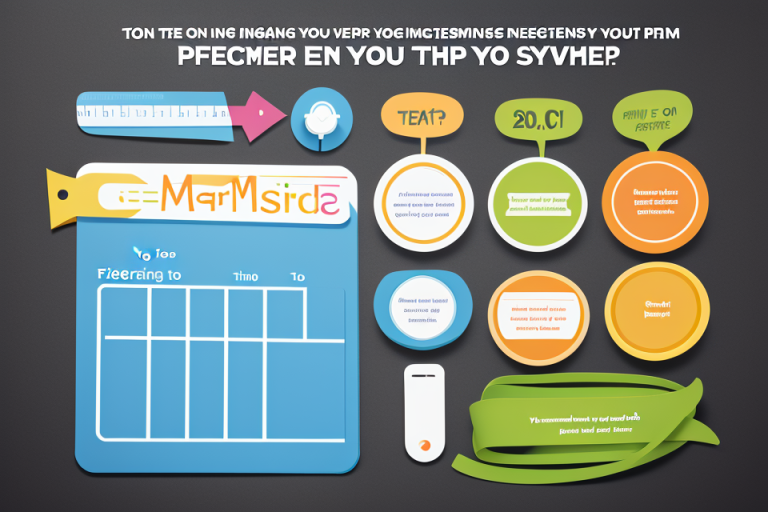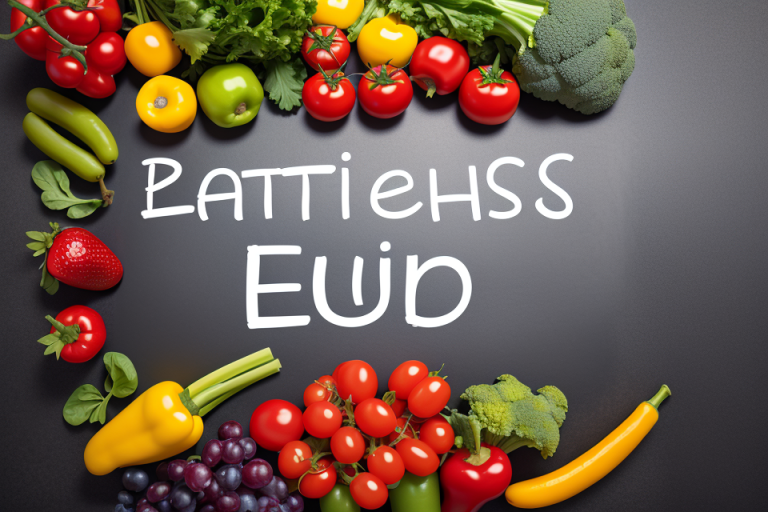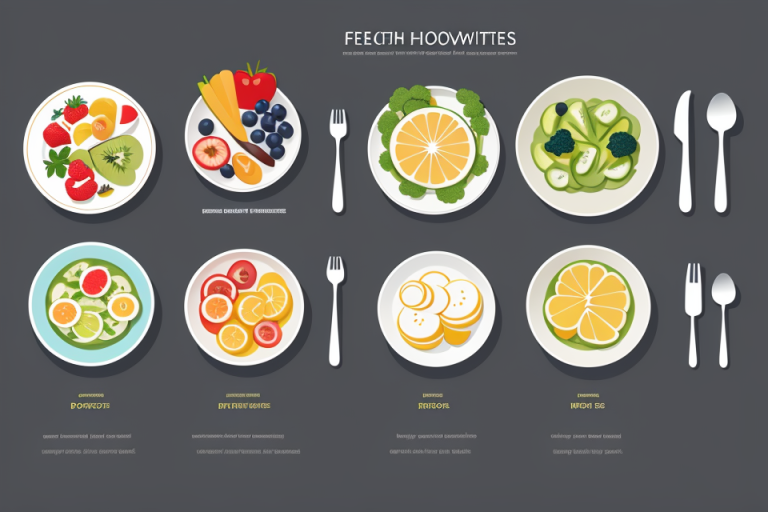How Can You Control Your Portions Effectively?
Portion control is a crucial aspect of maintaining a healthy diet. It is important to consume the right amount of food to avoid overeating and maintain a balanced diet. There are three methods of portion control that can help you control your portions effectively. These methods include using measuring cups and spoons, using portion control plates, and using your hands as a guide. In this article, we will explore each of these methods in detail and provide tips on how to use them to control your portions. By following these simple methods, you can enjoy your favorite foods without compromising your health goals.
Controlling your portions effectively can be achieved by paying attention to serving sizes, using smaller plates, and practicing mindful eating. It’s important to be aware of the appropriate serving sizes for different foods and to avoid overeating. Using smaller plates can help to control portion sizes, as it tricks the mind into thinking that the portion is larger. Mindful eating involves paying attention to the taste, texture, and flavor of food, and eating slowly to avoid overeating. It’s also helpful to plan meals in advance and to include a variety of foods in your diet to ensure that you’re getting all the nutrients you need. Finally, make sure to listen to your body’s hunger and fullness cues, and to stop eating when you feel satisfied, rather than stuffed.
Understanding Portion Control
The Importance of Portion Control
Maintaining a healthy diet requires a lot of things, but one of the most important is portion control. Portion control is the act of monitoring and controlling the amount of food you eat. It is essential to maintain a healthy weight, reduce the risk of obesity, and prevent other health problems such as heart disease, diabetes, and certain types of cancer.
One of the main reasons why portion control is important is that it helps you to eat the right amount of nutrients your body needs. Eating too much or too little of certain foods can lead to nutrient deficiencies, which can negatively affect your health. For example, if you eat too much sugar, you may be at risk for weight gain, type 2 diabetes, and other health problems. On the other hand, if you don’t eat enough fruits and vegetables, you may not get enough fiber, vitamins, and minerals, which are essential for maintaining good health.
Another reason why portion control is important is that it helps you to manage your calorie intake. Consuming more calories than your body needs can lead to weight gain, while consuming fewer calories than your body needs can lead to weight loss. Eating the right portion sizes can help you to consume the right number of calories for your body, which can help you to maintain a healthy weight or lose weight if needed.
Finally, portion control is important because it can help you to save money and reduce food waste. When you eat the right portion sizes, you can make sure that you are getting the most out of your food, which can help you to save money on groceries. Additionally, when you eat the right portion sizes, you are less likely to overeat, which can help you to reduce food waste and save money on food.
In summary, portion control is essential for maintaining a healthy diet, managing your calorie intake, and reducing the risk of obesity and other health problems. By monitoring and controlling the amount of food you eat, you can ensure that you are getting the right nutrients, saving money, and reducing food waste.
Common Myths About Portion Control
- “Small portions will leave me hungry.”
- “Eating less will slow down my metabolism.”
- “I need to eat until I’m full to lose weight.”
It’s time to debunk these common myths and learn the truth about portion control.
Strategies for Mindful Eating
One effective strategy for controlling your food portions is practicing mindful eating. This involves paying attention to your body’s hunger and fullness cues, as well as the taste and texture of your food. Here are some specific tips for practicing mindful eating:
- Take small bites: Eating smaller bites can help you slow down and savor your food, which can help you feel more full and satisfied with less food.
- Pay attention to your body’s cues: Listen to your body’s hunger and fullness signals, and stop eating when you feel satisfied, not stuffed.
- Eat with your non-dominant hand: Eating with your non-dominant hand can help slow down your eating pace and make you more aware of how much you’re eating.
- Practice mindfulness meditation: Mindfulness meditation can help you become more aware of your thoughts and feelings, which can help you develop a healthier relationship with food.
- Use a portion control tool: A portion control tool, such as a food scale or measuring cups, can help you accurately measure your food portions and track your progress over time.
By practicing mindful eating, you can develop a more intuitive understanding of your body’s hunger and fullness cues, which can help you make healthier food choices and control your portions more effectively.
Portion Control Methods
Visual Cues
One effective method for controlling your food portions is to use visual cues. This involves paying attention to the size of the food you are eating, as well as the size of the plate or bowl it is served on.
- Size Matters: Studies have shown that people tend to eat more when they are served larger portions. By using smaller plates or bowls, you can help to reduce the amount of food you eat.
- Food Shaping: Another visual cue technique is to shape your food into smaller portions. For example, instead of serving a large pile of pasta, you can divide it into smaller, more manageable portions.
- Plate Balance: You can also use the concept of balance to control your portions. Fill half of your plate with non-starchy vegetables, a quarter with lean protein, and a quarter with whole grains. This will help you to balance your meal and control your portion sizes.
- Labeling: Labeling your food can also be a helpful visual cue. Use measuring cups or a food scale to measure out your portions, and label the containers with the appropriate serving sizes. This can help you to monitor your intake and avoid overeating.
Overall, using visual cues can be a powerful tool for controlling your food portions. By paying attention to the size of your food and plate, you can make conscious decisions about how much you eat and maintain a healthy diet.
Plate Management
Plate management is a portion control method that involves using specific serving dishes and dividing food onto them in a way that promotes portion control. Here are some tips for using plate management to control your portions effectively:
- Use a salad plate for your main course: Instead of using a dinner plate, use a smaller salad plate for your main course. This can help you automatically eat less, as the smaller plate looks more filled than a larger one.
- Divide your plate into sections: Divide your plate into sections to help you visually control your portions. For example, divide your plate into sections for protein, vegetables, and starch. This can help you ensure that you’re getting a balanced meal with appropriate portion sizes.
- Use a rimmed plate: Using a rimmed plate can help you control your portions by making it easier to see when you’re full. The rim of the plate can also help you avoid spilling food, which can lead to overeating.
- Use a small bowl for snacks: Instead of using a large bowl for snacks, use a small bowl. This can help you control your portions and avoid mindless snacking.
- Use a buffet plate: If you’re eating at a buffet, use a smaller plate to help you control your portions. A smaller plate can help you avoid overloading your plate, which can lead to overeating.
By using plate management techniques, you can control your portions and eat more balanced meals. It’s important to remember that portion control is not about restricting yourself, but rather about being mindful of the food you eat and ensuring that you’re fueling your body with the appropriate amount of nutrients.
Measurement Techniques
Effective portion control relies heavily on measurement techniques. Here are some practical methods to measure your food portions accurately:
- Using Scales: Weighing and measuring your food on a kitchen scale is one of the most accurate methods. It’s especially helpful when working with liquid or non-solid foods, like soup or oatmeal. Be sure to zero out the scale before each use to ensure accuracy.
- Visual Cues: For solid foods, use visual cues like cups, bowls, or measuring spoons. For example, a single serving of pasta is typically 1/2 cup, while a single serving of rice is 1/3 cup. These visual cues can help you gauge appropriate portions for various foods.
- Plate Method: This method involves using a dinner plate that is divided into sections, each representing a serving size. For instance, a plate divided into four sections would have one section representing a single serving. This can be a helpful visual guide when planning meals.
- Portion Control Plates and Bowls: There are specialized plates and bowls available with pre-marked portion sizes. These can be helpful in providing a clear reference for proper portion sizes.
- Lean Cuisine: This is a technique where you use smaller plates or bowls to trick your brain into thinking you’re eating more than you are. Research suggests that using smaller dishes can help reduce food intake.
- Hand Method: For foods that don’t have a standard serving size, like meat or fish, use the palm of your hand as a guide. A serving of meat should be about the size of a deck of cards, while a serving of fish should be about the size of your palm.
By employing these measurement techniques, you can ensure that you‘re consuming appropriate portion sizes and better manage your food intake.
Pros and Cons of Each Method
When it comes to portion control, there are several methods that can be used to help you manage your food intake effectively. Here are some of the most common methods, along with their pros and cons:
- Plate Method
- Pros: Helps you visually estimate appropriate portion sizes, encourages mindful eating.
- Cons: Does not account for differences in food density, may lead to overeating if not paired with other methods.
- Measuring Cups and Scales
- Pros: Provides precise portion sizes, easier to adjust serving sizes based on nutritional needs.
- Cons: May be time-consuming, not practical for every meal, can be costly to purchase high-quality measuring tools.
- Food Diaries and Tracking Apps
- Pros: Helps you track your food intake, encourages self-reflection and awareness of portion sizes.
- Cons: May be time-consuming, requires consistent effort to track, may lead to underreporting or overreporting of food intake.
- Serving Bowls and Plates
- Pros: Encourages mindful eating, can help reduce portion sizes.
- Cons: May not account for differences in food density, may lead to overeating if not paired with other methods.
- Intermittent Fasting
- Pros: Can help reduce calorie intake, improve metabolic health, simplify meal planning.
- Cons: May not be suitable for everyone, can lead to overeating during non-fasting periods, may not provide enough nutrients for some individuals.
By understanding the pros and cons of each method, you can choose the one that best suits your individual needs and lifestyle. It’s also important to remember that portion control is just one aspect of a healthy diet, and should be combined with regular physical activity and a balanced diet to achieve optimal health outcomes.
Examples of How to Use Each Method
One of the most effective ways to control your portions is to use measuring cups or spoons to portion out your food. This can help you to better visualize how much you are eating and ensure that you are not overeating. For example, if you are trying to eat more vegetables, you can portion out a specific amount of vegetables onto your plate at each meal. This can help you to make sure that you are getting enough vegetables in your diet without overeating other foods.
Another method for controlling your portions is to use smaller plates or bowls. This can help to trick your brain into thinking that you are eating more because the visual size of the food on your plate is larger. For example, if you are having pasta for dinner, you can use a smaller plate to portion out your pasta. This can help you to eat less pasta overall, while still feeling satisfied with your meal.
Another useful tip for controlling your portions is to eat slowly and mindfully. This can help you to better recognize when you are feeling full, and can also help you to enjoy your food more. For example, if you are having a salad for lunch, you can take small bites and chew slowly to help you to feel full. This can also help you to better appreciate the flavors and textures of your food.
Finally, it can be helpful to practice portion control by using leftovers. For example, if you cook a large pot of soup, you can portion out the soup into individual servings and store them in the refrigerator for later. This can help you to control your portions and avoid overeating, while also reducing food waste.
Overall, there are many different methods that you can use to control your portions effectively. By using measuring cups, smaller plates or bowls, eating slowly and mindfully, and using leftovers, you can help to ensure that you are eating the right amount of food to meet your nutritional needs and support your health goals.
Tips for Maintaining Portion Control
Creating a Healthy Environment
When it comes to controlling your food portions, the environment you eat in plays a crucial role. Here are some tips for creating a healthy environment that can help you maintain portion control:
- Eat in the right setting: Try to avoid eating in front of the TV or while browsing social media. Instead, eat in a calm and quiet environment, preferably at a table with proper utensils. This can help you pay more attention to your food and avoid mindless eating.
- Use smaller plates: Studies have shown that using smaller plates can help you eat less. This is because smaller plates appear to be more filled, so you’re likely to eat less even if you’re consuming the same amount of food. Try using salad plates instead of dinner plates to help control your portion sizes.
- Keep healthy snacks within reach: If you’re prone to snacking, keep healthy snacks within reach. This can help you avoid reaching for unhealthy snacks when you’re hungry. Some good options include fruits, veggies, and nuts.
- Get rid of temptations: If there are certain foods that you know you can’t resist, get rid of them. This might mean hiding them in a cupboard or throwing them out altogether. Out of sight, out of mind!
- Make healthy foods convenient: If you have healthy foods readily available, you’re more likely to eat them. This might mean washing and chopping veggies ahead of time, or keeping pre-cut fruit in the fridge.
By creating a healthy environment, you can make it easier to control your food portions and make healthier choices.
Preparing Meals in Advance
Preparing meals in advance is a useful strategy for maintaining portion control. By cooking larger quantities of food at once, you can ensure that you have healthy, appropriately sized portions on hand throughout the week. Here are some tips for preparing meals in advance:
- Plan your meals: Before you start cooking, take some time to plan out your meals for the week. This will help you make sure you have a variety of healthy options on hand, and it will also help you determine how much food you need to prepare.
- Cook in batches: When you’re cooking, try to prepare larger batches of food. This will allow you to portion out the food into individual servings, which you can then store in the fridge or freezer for later.
- Use portion-sized containers: To make it easier to control your portions, use portion-sized containers when storing your food. This will help you avoid overeating, as you’ll be able to see exactly how much food you have left.
- Consider meal prepping: Meal prepping is a great way to ensure that you have healthy, appropriately sized portions on hand throughout the week. Set aside some time on the weekend to cook and portion out your meals for the week. This will save you time during the week and help you stick to your portion control goals.
By preparing meals in advance, you can ensure that you have healthy, appropriately sized portions on hand throughout the week. This can help you stick to your portion control goals and make healthy eating a convenient and sustainable part of your daily routine.
Using Smaller Dishes
When it comes to controlling your food portions, using smaller dishes can be a simple yet effective strategy. Here are some tips on how to use smaller dishes to help you eat less:
- Choose Smaller Plates
One way to control your portions is to use smaller plates. This can help you automatically eat less, as your eyes will be more likely to fill up with food before your stomach does. Using smaller plates can also make your meal look more appealing, which can help you feel more satisfied with less food. - Use Salad Plates for Protein and Vegetables
When it comes to protein and vegetables, using salad plates instead of dinner plates can be a helpful strategy. Salad plates are typically smaller than dinner plates, so you’ll be less likely to overload your plate with too much food. Additionally, using salad plates can make your meal look more balanced and colorful, which can help you feel more satisfied with less food. - Use Ramekins or Small Bowls for Snacks
When it comes to snacking, using small ramekins or bowls can be a helpful strategy. This can help you control your portion sizes and avoid mindless snacking. Instead of reaching for a bag of chips or a big bowl of popcorn, reach for a small ramekin or bowl instead. Fill it with a small amount of your favorite snack, and then put the rest away. This can help you feel more satisfied with less food and avoid overeating. - Use Smaller Cups for Beverages
When it comes to beverages, using smaller cups can also be a helpful strategy. This can help you control your portion sizes and avoid mindless drinking. Instead of reaching for a big glass or bottle, reach for a smaller cup instead. Fill it with a small amount of your favorite beverage, and then put the rest away. This can help you feel more satisfied with less food and avoid overeating.
By using smaller dishes, you can help control your food portions and avoid overeating. Whether you’re using smaller plates, salad plates, ramekins, or small bowls, these simple strategies can help you make healthier choices and feel more satisfied with less food.
Overcoming Obstacles to Portion Control
Common Obstacles
Emotional Eating
Emotional eating is a common obstacle to portion control. It is when people use food as a way to cope with their emotions, such as stress, boredom, or sadness. This can lead to overeating and a lack of control over portion sizes.
Environmental Factors
Environmental factors can also impact portion control. For example, large serving sizes and all-you-can-eat buffets can encourage overeating. Additionally, having unhealthy foods readily available, such as in vending machines or at work, can make it difficult to resist the temptation to eat more than intended.
Lack of Planning
Lack of planning is another common obstacle to portion control. Without a plan, it can be easy to overeat or consume too many calories. This can be particularly challenging when eating out or when there are distractions, such as watching TV or using a computer, while eating.
Restaurant Portions
Restaurant portions can also be a challenge when it comes to portion control. Portions are often larger than what is recommended, and it can be difficult to ask for a smaller serving or to take leftovers home. This can lead to overeating and consuming excess calories.
Social Influences
Social influences, such as friends or family members, can also impact portion control. If those around you are consuming large portions or encouraging you to eat more, it can be challenging to resist the temptation. Additionally, social events or celebrations often involve food, which can make it difficult to stick to portion control.
Strategies for Overcoming Obstacles
Tips for Mindful Eating
- Practice Mindful Meditation: Mindful meditation is a technique that helps individuals to focus on the present moment, which can be beneficial in controlling food portions.
- Use Smaller Plates: Using smaller plates can help control food portions. Studies have shown that people tend to eat less when they use smaller plates.
- Pay Attention to Hunger and Fullness Cues: Paying attention to hunger and fullness cues can help individuals control their food portions. It is important to eat when hungry and stop when full.
Setting Realistic Goals
- Set Achievable Goals: Setting achievable goals can help individuals overcome obstacles to portion control. It is important to set realistic goals that are attainable and gradually increase them over time.
- Track Progress: Tracking progress can help individuals stay motivated and on track with their portion control goals. It is important to keep track of progress and celebrate small victories.
Making Healthy Food Choices
- Choose Whole Foods: Choosing whole foods such as fruits, vegetables, and whole grains can help individuals control their food portions. Whole foods are nutrient-dense and can help individuals feel fuller for longer.
- Limit Processed Foods: Limiting processed foods can help individuals control their food portions. Processed foods are often high in calories, sugar, and unhealthy fats, which can lead to overeating.
- Plan Meals in Advance: Planning meals in advance can help individuals control their food portions. It is important to plan meals that are balanced and include a variety of foods.
Recap of Key Points
- Identifying Triggers: One of the key points in overcoming obstacles to portion control is recognizing the triggers that lead to overeating. These triggers can be emotional, social, or environmental and understanding them can help in developing strategies to overcome them.
- Mindful Eating: Mindful eating is another important aspect of overcoming obstacles to portion control. It involves paying attention to the food while eating, recognizing hunger and fullness cues, and eating slowly. This can help in avoiding overeating and making healthier food choices.
- Using Smaller Plates: Using smaller plates can also help in controlling portions. Research has shown that people tend to eat less when they use smaller plates. This is because using smaller plates can make the portion appear larger, leading to a feeling of fullness.
- Preparing Meals in Advance: Preparing meals in advance can also be helpful in controlling portions. This can help in avoiding the temptation of unhealthy snacks and can also ensure that the correct portion sizes are being consumed.
- Seeking Support: Seeking support from friends, family, or a professional can also be helpful in overcoming obstacles to portion control. This can provide accountability and motivation to stick to healthy eating habits.
The Benefits of Effective Portion Control
- Improved nutrition and health: Effective portion control can help you consume the appropriate amount of nutrients your body needs. By controlling your portion sizes, you can ensure that you are getting the right balance of macronutrients such as carbohydrates, proteins, and fats, which are essential for maintaining good health.
- Weight management: Portion control is an effective tool for weight management. By monitoring your portion sizes, you can prevent overeating and reduce your calorie intake, which can help you maintain a healthy weight or lose weight if needed.
* Better digestion and energy levels: Eating the right portion sizes can also improve your digestion and energy levels. Consuming too much food at one time can lead to digestive issues such as bloating and discomfort, while eating too little can leave you feeling lethargic and fatigued. By controlling your portion sizes, you can ensure that you are eating enough to fuel your body and support good digestion. - Reduced food waste: Effective portion control can also help reduce food waste. By planning your meals and controlling your portion sizes, you can ensure that you are using all the ingredients you have and not throwing away excess food. This can help save money and reduce your environmental impact.
- Improved satiety: Portion control can also help improve your satiety or feeling of fullness. By eating the appropriate portion sizes, you can ensure that you are getting enough nutrients to feel satisfied and full, which can help prevent overeating and snacking.
Overall, effective portion control can have numerous benefits for your health, weight management, digestion, energy levels, and the environment. By controlling your portion sizes, you can ensure that you are getting the right balance of nutrients and fueling your body in a healthy way.
Next Steps for Successful Portion Control
- Assess Your Environment
The first step in successful portion control is to assess your environment. This means taking a look at the foods that are readily available to you and making sure that healthy options are easily accessible. If you know that you have a tendency to overeat when certain foods are around, it may be helpful to remove them from your environment altogether.
- Plan Your Meals in Advance
Another important step in successful portion control is to plan your meals in advance. This means taking the time to think about what you will eat for each meal and making sure that you have the right portion sizes. Planning your meals ahead of time can also help you save time and money, as you can buy the ingredients you need in advance and have them on hand when you need them.
- Use Smaller Plates
Using smaller plates can also be an effective way to control your portions. This is because larger plates can make it easier to overeat, as they give the illusion of a smaller portion size. By using smaller plates, you can trick your brain into thinking that you are eating more than you actually are.
- Use Measuring Cups and Scales
Another helpful tip for successful portion control is to use measuring cups and scales. This can help you to ensure that you are eating the right portion sizes and can help you to keep track of your food intake. By measuring out your portions, you can also make sure that you are getting the right balance of nutrients.
- Stay Hydrated
Staying hydrated is also important for successful portion control. This is because thirst can often be mistaken for hunger, leading to overeating. By staying hydrated, you can avoid this mistake and make sure that you are only eating when you are truly hungry.
- Practice Mindful Eating
Finally, practicing mindful eating can be an effective way to control your portions. This means paying attention to your food as you eat it, savoring each bite, and being aware of your hunger and fullness cues. By being mindful of your food, you can avoid mindless eating and make sure that you are only eating when you are truly hungry.
FAQs
1. What are the three methods of portion control?
The three methods of portion control are:
* The plate method: This method involves using a smaller plate to portion out food. This can help to reduce the amount of food that is consumed, as people tend to eat less when they are served smaller portions.
* The divided plate method: This method involves dividing a larger plate into smaller sections, and then filling each section with a different food. This can help to ensure that people are getting a balanced meal, and can also help to prevent overeating.
* The cup method: This method involves using a measuring cup to portion out food. This can be especially helpful when portioning out snacks or small amounts of food, as it allows people to easily see how much they are consuming.
2. How can I use the plate method to control my portions?
To use the plate method to control your portions, simply use a smaller plate when serving yourself food. This can help to reduce the amount of food that you consume, as people tend to eat less when they are served smaller portions. For example, instead of using a large plate, use a smaller salad plate or a dinner plate that is slightly smaller than the standard size.
3. How can I use the divided plate method to control my portions?
To use the divided plate method to control your portions, simply divide a larger plate into smaller sections, and then fill each section with a different food. This can help to ensure that you are getting a balanced meal, and can also help to prevent overeating. For example, you could divide a large plate into four sections, with one section for protein, one section for vegetables, one section for carbohydrates, and one section for fruit.
4. How can I use the cup method to control my portions?
To use the cup method to control your portions, simply use a measuring cup to portion out food. This can be especially helpful when portioning out snacks or small amounts of food, as it allows you to easily see how much you are consuming. For example, you could use a measuring cup to portion out a serving of nuts or chips, or to measure out a specific amount of cereal or oatmeal for breakfast.







